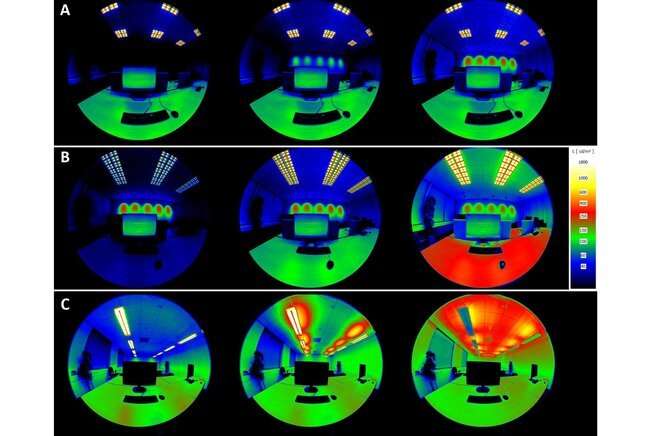Experiments with different lighting situations (wall, desk and ceiling). Credit: Eindhoven University of Technology
Although we usually do not realize this, lighting is an essential part of our daily lives. After all, without light, no sight. Next to enabling us to see safely and comfortably move from place A to B, lighting also has a large impact on how we perceive and appreciate spaces. Ph.D. student Adrie de Vries has investigated how lighting affects the experience and performance of knowledge workers in an open-plan office. He will defend his thesis on Wednesday 24 November at the departent of Industrial Engineering and Innovation Sciences.
We all know the effect of bars or cafés who turn on the 'cleaning light' to signal the customers that the party is over, turning a space from a cozy bar, to a boring, unappealing space. Moreover, lighting has an impact on the synchronization of our biological clock. This is not something we notice directly, but considering that we spend more than 90 percent of our time indoor, 'shielding' ourselves from daylight, the office lighting can play a key role to provide an artificial (partial) alternative. But how does office lighting affect these different aspects?
Wall, desk and ceiling
To investigate this, Adrie de Vries used three separate experiments to analyze how office workers perceived and experienced different lighting effects on the wall, the desk and the ceiling respectively. He also tried to relate this to task performance of knowledge workers. Although these types of investigations are typically done in highly controlled and often unrealistic environments, he chose environments that closely mimicked realistic, multi-user offices to ensure that the findings would also be representative and applicable to real world cases.
First, the effect of lighting the wall was studied and was found to have a clear effect on how people experienced the space. Increasing the light level on the wall rendered not only a brighter but also a more attractive environment. Moreover, although he did not find any effects on task performance, people did feel more alert in the spaces with more light on the walls and they stayed more alert there as well.
In contrast, varying the amount of light on the desk (with a constant amount of light on the wall) mainly impacted how well people could read from paper, and how bright people perceived the space, but did not impact alertness, task performance, or the attractiveness of the office space.
For the ceiling illumination, he found an increase in attractiveness and brightness when more light was directed to the ceiling. Additionally, the spaces were judged more attractive when spreading the light more evenly over the ceiling.
Appreciative vs. indifferent
Another important finding was that not all participants were equally sensitive and appreciative to changes in brightness. Although people having different opinions of what they like is not new, the fact that the researcher could clearly separate them in a sensitive, appreciative group and an indifferent, mildly negative group, was a new and useful finding for future research.
Finally, De Vries investigated if he could predict the brightness perceptions of individuals with accurate measurements of the lighting. He found that measurements of specific parts of the field of view provided a reasonable prediction of how bright people would assess the space and that both the average and the contrast in the field of view mattered.
Integrative design and diversity
The researcher concludes that illuminating the walls, ceilings and desks can all result in brighter spaces, however, in this case, only lighting the walls and ceiling resulted in more attractive spaces. Additionally, lighting for example the walls can also support occupants in maintaining their alertness instead of becoming more sleepy. This shows that lighting does more than simply provide sufficient light to read, but also impacts how we experience spaces, and how we "feel."
Importantly though, although it was possible to draw several overall conclusions, we are dealing with a highly diverse workforce, which can and will have different requirements for their "great place to work."
More information: Lighting up the 'great place to work': pure.tue.nl/ws/portalfiles/por … 0211124_Vries_hf.pdf
Provided by Eindhoven University of Technology
























